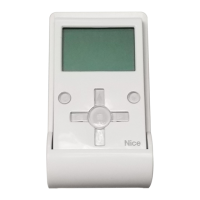Oview operation manual
Enclosure
E.67
Rev 4.00
In conformity with the Machinery Directive 2006/42/EC and applicable parts of the EN standards EN 13241-1; EN 12453; EN 12445; EN 12635
01/09/2010
GENERAL SAFETY WARNINGS AND PRECAUTIONS
CAUTION! – All installation procedures, connections, programming and maintenance of the product must be performed
by a qualified technician!
Observe the following warnings:
– keep Oview out of the reach of children.
– for cleaning the product surfaces, use a slightly damp (not wet) cloth. Important – Never use substances containing alcohol,
benzene, diluents or other flammable substances. Use of such substances could damage the product.
– handle the LCD screen with care, taking care to avoid scratching.
– keep this manual in a safe place to enable future consultation.
– at the end of the product lifetime, ensure that it is recycled or scrapped according to current standards in the place of
use.
DESCRIPTION OF OVIEW
The use of Oview as a fixed wall-mounted control unit enables the product to remain active at all times as it is powered directly
and permanently by the automation to which it is connected. However, if Oview is not used for a short period of time, the screen
sets to standby (reduced brightness). In this case, to restore brightness, press any key. To control an automation, simply recall the
name and icon of the automation on the Oview screen and send a command by pressing a key (for further information refer to the
chapter “Using Oview as a control device”).
Oview comprises the following parts:
1
LCD screen;
2 / 4
rrow keys ◄ and ►: used to move from one field to another in
a window and to move from one window to another;
3 / 5
rrow keys ▲ and ▼: used to modify values in a selected field
or to browse within a list;
6
Key ■ used to confirm a value;
7
Key ● used to select the item displayed at the bottom left of the
screen (9);
8
Key ● used to select the item displayed at the bottom right of the
screen (10).
After activating Oview, the application home page is displayed.
This window comprises the following elements:
A. Icon defining the type of device connected; in the case of a network of
devices the screen displays the first device found automatically, belonging
to specific group.
B. Name of selected device.
C. Number indicating the series to which the selected device belongs.
D. Local date and time
E. “commands”: this enables the user to access all functions available to
control one or more devices.
F. “menu”: this enables the user to access all functions available to program a
device.
Document produced by Nice S.p.a. for installers – All rights reserved
Page ____ of ______





